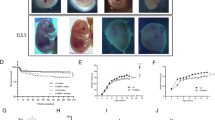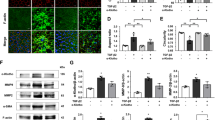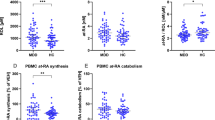Abstract
A consanguineous pedigree is described where 14 individuals are affected with a novel autosomal recessive disorder, which causes static moderate mental retardation, truncal obesity, a congenital nonprogressive retinal dystrophy and micropenis in males. We have tentatively named this condition MORM syndrome. It shows similarities to Bardet–Biedl syndrome and Cohen syndrome, but can be distinguished by clinical features; the age of onset and nonprogressive nature of the visual impairment, the lack of characteristic facies, skin or gingival infection, microcephaly, ‘mottled retina’, polydactyly and small penis without testicular anomalies. Furthermore, linkage to the known Bardet–Biedl (BBS1–8) and Cohen syndrome loci was excluded. Autozygosity mapping identified a single homozygous subtelomeric region shared by all affecteds on chromosome 9q34.3, with a maximum LOD score of 5.64. We believe this to be the first example of the identification of a subtelomeric recessive locus by autozygosity mapping.
Similar content being viewed by others
Log in or create a free account to read this content
Gain free access to this article, as well as selected content from this journal and more on nature.com
or
References
Mykytyn K, Sheffield VC : Establishing a connection between cilia and Bardet–Biedl Syndrome. Trends Mol Med 2004; 10: 106–109.
Mykytyn K, Nishimura DY, Searby CC et al: Identification of the gene (BBS1) most commonly involved in Bardet–Biedl syndrome, a complex human obesity syndrome. Nat Genet 2002; 31: 435–438.
Nishimura DY, Searby CC, Carmi R et al: Positional cloning of a novel gene on chromosome 16q causing Bardet–Biedl syndrome (BBS2). Hum Mol Genet 2001; 10: 865–874.
Young T-L, Woods MO, Parfrey PS et al: Canadian Bardet–Biedl syndrome family reduces the critical region of BBS3 (3p) and presents with a variable phenotype. Am J Med Genet 1998; 78: 461–467.
Mykytyn K, Braun T, Carmi R et al: Identification of the gene that, when mutated, causes the human obesity syndrome BBS4. Nat Genet 2001; 28: 188–191.
Young T-L, Penney L, Woods MO et al: A fifth locus for Bardet–Biedl syndrome maps to chromosome 2q31. Am J Hum Genet 1999; 64: 900–904.
Slavotinek AM, Stone EM, Mykytyn K et al: Mutations in MKKS cause Bardet–Biedl syndrome. Nat Genet 2000; 26: 15–16.
Katsanis N, Beales PL, Woods MO et al: Mutations in MKKS cause obesity, retinal dystrophy and renal malformations associated with Bardet–Biedl syndrome. Nat Genet 2000; 26: 67–70.
Badano JL, Ansley SJ, Leitch CC, Lewis RA, Lupski JR, Katsanis N : Identification of a novel Bardet–Biedl syndrome protein, BBS7, that shares structural features with BBS1 and BBS2. Am J Hum Genet 2003; 72: 650–658.
Ansley SJ, Badano JL, Blacque OE et al: Basel body dysfunction is a likely cause of pleiotropic Bardet–Biedl syndrome. Nature 2003; 425: 628–633.
Katsanis N : The oligogenic properties of Bardet–Biedl syndrome. Hum Mol Genet 2004; 13: R65–R71.
Kivitie-Kallio S, Norio R : Cohen syndrome: essential features, natural history, and heterogeneity. Am J Med Genet 2001; 102: 125–135.
Kolehmainen J, Norio R, Kivitie-Kallio S, Tahvanainen E, de la Chapelle A, Lehesjoki AE : Refined mapping of the Cohen syndrome gene by linkage disequilibrium. Eur J Hum Genet 1997; 5: 206–213.
Reed PW, Davies JL, Copeman JB et al: Chromosome-specific microsatellite sets for fluorescence-based, semi-automated genome mapping. Nat Genet 1994; 7: 390–395.
Rozen S, Skaletsky HJ : Primer3 on the WWW for general users and for biologist programmers; in Misener S, Krawetz SA (eds): Bioinformatics Methods and Protocols: Methods in Molecular Biology. Totowa, NJ: Humana Press, 2000, pp 365–386.
Tatusova TA, Madden TL : BLAST 2 sequences, a new tool for comparing protein and nucleotide sequences. FEMS Microbiol Lett 1999; 174: 247–250.
American Psychiatric Association: Diagnostic and Statistical Manual of Mental Disorders (DSM IV). Washington, DC: American Psychiatric Association, 1994.
O'Connell JR, Weeks DE : PedCheck: a program for identification of genotype incompatibilities in linkage analysis. Am J Hum Genet 1998; 63: 259–266.
Kruglyak L, Daly MJ, Reeve-Daly MP, Lander ES : Parametric and nonparametric linkage analysis: a unified multipoint approach. Am J Hum Genet 1996; 58: 1347–1363.
Beales PL, Elcioglu N, Woolf AS, Parker D, Flinter FA : New criteria for improved diagnosis of Bardet–Biedl syndrome: results of a population survey. J Med Genet 1999; 36: 437–446.
Woods MO, Young T-L, Parfrey PS, Hefferton D, Green JS, Davidson WS : Genetic heterogeneity of Bardet–Biedl syndrome in a distinct Canadian population: evidence for a fifth locus. Genomics 1999; 55: 2–9.
Sanada K, Tsai L-H : G protein betagamma subunits and AGS3 control spindle orientation and asymmetric cell fate of cerebral cortical progenitors. Cell 2005; 122: 119–131.
Hamil KG, Liu Q, Sivashanmugam P et al: LCN6, a novel human epididymal lipocalin. Reprod Biol Endocrinol 2003; 1: 112.
Acknowledgements
We thank the family members and their physicians who helped with this study. DJH is supported by the Medical Research Council. KS, ER, HJ, JB and CGW are supported by the Wellcome Trust.
Author information
Authors and Affiliations
Corresponding author
Additional information
Competing interests: The authors declare that they have no competing financial interests.
Electronic-Database Information: Online Mendelian Inheritance of Man (OMIM) for clinical and genetic information on Bardet–Biedl syndrome (209900) and Cohen syndrome (216550):
http://www.ncbi.nlm.nih.gov/entrez/query.fcgi?db=OMIM
Genome Database (GDB) for polymorphic microsatellite data:
Human Genome Browser for loci, gene, polymorphic marker and SNP physical location data for the human genome:
http://genome.cse.ucsc.edu/cgi-bin/hgGateway?org=human
Center for Medical Genetics for the Marshfield Linkage Maps:
http://research.marshfieldclinic.org/genetics/Map_Markers/maps/IndexMapFrames.html
Primer3 for design of novel microsatellite repeat markers:
http://www-genome.wi.mit.edu/cgi-bin/primer/primer3_www.cgi BLAST 2 for SNP sequence analysis:
Rights and permissions
About this article
Cite this article
Hampshire, D., Ayub, M., Springell, K. et al. MORM syndrome (mental retardation, truncal obesity, retinal dystrophy and micropenis), a new autosomal recessive disorder, links to 9q34. Eur J Hum Genet 14, 543–548 (2006). https://doi.org/10.1038/sj.ejhg.5201577
Received:
Revised:
Accepted:
Published:
Issue date:
DOI: https://doi.org/10.1038/sj.ejhg.5201577
Keywords
This article is cited by
-
A Comprehensive Review of Syndromic Forms of Obesity: Genetic Etiology, Clinical Features and Molecular Diagnosis
Current Obesity Reports (2024)
-
A roadmap to increase diversity in genomic studies
Nature Medicine (2022)
-
Moonlighting of mitotic regulators in cilium disassembly
Cellular and Molecular Life Sciences (2021)
-
PDE6δ-mediated sorting of INPP5E into the cilium is determined by cargo-carrier affinity
Nature Communications (2016)
-
Alström syndrome: insights into the pathogenesis of metabolic disorders
Nature Reviews Endocrinology (2011)



